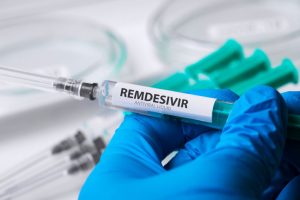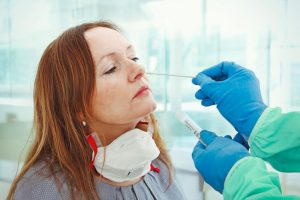Reviewed by Abbie Jacobs, RN, BSN
News that the FDA authorized the use of remdesivir as a treatment for COVID-19 patients on May 1st has been making waves in public health circles and beyond.
Remdesivir, or RDV, an anti-viral drug designed to fight Ebola, had been sitting on the shelf for the past five years or so. But COVID-19 has sent researchers scurrying through the back catalogs of pharmacology in search of drugs that might help treat the hundreds of thousands of patients suffering during the pandemic.
National Institute of Allergy and Infectious Diseases (NIAID) director Doctor Anthony Fauci called the drug “quite good news” and said that it would set a new standard of care for COVID-19 patients. If it lives up to the promise, RDV could be a very welcome development for public health officials looking to assemble the right collection of tools they need to be effective in the fight against COVID-19.
What is Remdesivir and How is it Used?

Remdesivir was developed in 2015 as a part of a crash program to find treatments for the West African Ebola epidemic underway at that time. Created by Gilead Sciences, the drug showed antiviral capabilities when pitted against a number of different viruses, including coronaviruses.
It also went through limited trials against Ebola itself, before being discarded in favor of more effective treatments. But it did pass a number of expedited, but important, human safety studies at the time.
Crucially, the drug has already been tested both in vitro and in monkeys against SARS-CoV-2 and was found to be effective.
Remdesivir comes as a powder and has to be reconstituted to liquid form before being given to patients. It’s administered intravenously, so patients have to be intravenously accessed first.
The FDA recommends infusion of 100-200mg over 30-120 minutes for 10 days, although the dosage may vary by patient and condition, and other treatment patterns are being explored on a case by case basis.
Like most modern drugs, remdesivir comes with its share of side effects. But the good news is that they are relatively minor. Some of these include constipation, anemia and other blood electrolyte abnormalities. In fact, in a Chinese trial, the placebo group experienced more significant adverse effects than those on RDV. Of course, with relatively small numbers tested so far, it’s possible that other effects may emerge.
The Announcement Comes Just as Tensions Over Stay-at-Home Orders are Boiling Over

“Anchoring” is a term that public health professionals will need to get used to as the country discusses relaxing social distancing guidelines and getting the economy back in gear. It’s a psychological term that refers to the very human tendency of depending too heavily on an initial piece of information when making decisions.
This happens across the spectrum of coronavirus debates as people either project their recollections of past economic activity onto likely future events, or latch on to the latest type of test, treatment, or contact tracing technique with a glimmer of promise. Psychological anchoring leads to new information, or other facts, being ignored as people cling to their original impressions.
When you’re in the middle of a pandemic, with new information coming into the picture daily, it’s a bad time to develop tunnel vision. The challenge for public health workers will be to keep all the information that’s picked up as the situation evolves and apply it to every decision moving forward rather than allowing any one piece of news to dictate the appropriate course of action. It’s hard to imagine a more complex environment for decision-making.
Right now, many people appear to be anchored to one of two positions – on one side are those who think we should maintain stay-at-home orders to reduce fatalities and the burden on healthcare workers until a vaccine is found… and on the other side are those anxious to see the economy reopen to avoid long-term financial reprocussions and other lasting damage to public health and welfare.
Even though Remdezivir can’t do anything to address the core crux of this debate by actually stemming the spread of the disease, the news that it could save the lives of those hardest hit has removed some of the fangs from COVID-19, and certainly adds something new to an already complex and heated debate.
Nothing is Clear-Cut When Weighing Public Health and Economic Consequences
Comparing the outcomes of re-opening versus remaining locked down requires numbers that we simply don’t have. Even the most basic comparison of the mortality risk of COVID-19 versus the long-term fallout from economic shutdowns quickly falls apart when we start looking into it.
According to the Center for Evidence Based Medicine, the current estimated range of COVID-19 infection fatality is likely between 0.1% and 0.36%. With a naive R0 of between 5 and 6 found in early data from Wuhan, that leads to a tremendous number of global fatalities if governments don’t impose the proper interventions.
But those interventions are also responsible for creating economic issues that also impact public health. In fact, the COVID-19 lockdowns have created a set of problems that are inflaming some of the oldest and biggest global heath issues.
The World Food Program projects that the number of people facing acute food insecurity worldwide is set to double as a result of the economic impact of the shutdowns. It’s well known that unemployment by itself is responsible for higher mortality rates for a host of reasons – suicide and more alcohol-related deaths being chief among them. That’s not to mention the fact that most health insurance in the U.S. is tied to employment, putting basic healthcare for millions at risk as the economy contracts.
Is the Cure Really Worse than the Disease? – Complications Quickly Emerge in Basic Comparisons
But even if you account for the uncertainty in all those numbers—which researchers readily acknowledge—it quickly becomes clear that much of what we think we know might not actually apply right now.
In some cases, such as in India, stay-at-home orders have actually improved public safety across the board, with lower all-cause death rates likely driven by a decrease in accidents and crime.
With studies pointing to increased smoking, drinking and mental health problems associated with job loss, the main cure-is-worse-than-the-disease argument for lifting stay-at-home orders is that unemployment could lead to a significant spike in these kinds of public health issues among the jobless.
But with COVID-19 claiming lives daily and dominating the headlines, there are a whole host of other stressors contributing to the exact same type of unhealthy behaviors – and these stressors won’t disappear by simply letting people go back to their jobs. The question now is whether or not the remdesivir announcement could take the edge off those stressors enough to make a stronger argument for lifting lockdowns.
It’s also the case that the economy is currently so globalized that even if specific countries or regions figure out the secret to opening up without dramatically increasing COVID-related deaths, it won’t necessarily just flip the economic switch to warp speed. China has reopened to a great extent, but with demand plunging from the rest of the world, it has hardly been a panacea for their economic situation. And Sweden, held up by many on the re-open side of the debate as a paragon of what a recovery might look like, is still projected to suffer a worse GDP decline than the United States, purchased with a far higher fatality rate—not exactly the trade-off they were hoping for.
It’s clear that lifting stay-at-home constraints will have to be judged not against what the economy used to be, but what it’s actually likely to be in a world where priorities and consumer habits have shifted in response to the threat.
How Will Public Health Officials Proceed with So Much Uncertainty and Risk?

It’s clear that the current situation in the U.S. is unsustainable. A majority of Americans support the current stay-at-home orders—or even feel they don’t go far enough—according to recent polling by the Associated Press. But everyone is also anxious for an effective plan to return to some sort of normalcy in a safe way.
As those plans emerge, you can’t help but notice that they have strikingly similar features regardless of which side of the political spectrum they come from:
- Continue national lockdown for a period to flatten the infection curve
- Increase health system capacity during that period
- Relax restrictions while engaging in large-scale testing and surveillance
Similar plans have emerged in other nations, and the U.S. has the benefit of being able to see how those plans unfold as they are rolled out.
New Zealand’s approach will be worth watching as it emerges from stay-at-home orders earlier than the U.S. thanks to the fact that is was early and particularly effective in its initial response. After 33 days of strict lockdown, the country is gradually easing restrictions by opening around 75% of the economy. The move is happening in tandem with heavy test-and-tracing protocols and some social distancing restrictions.
But an isolated island nation will also have limited lessons to offer a diverse, heavily connected country like the United States. You also can’t ignore the fact that Singapore, with similar advantages as an island nation and a robust tracing system, still failed spectacularly in containing their second wave using a similar strategy.
What COVID-19 Studies of Remdesivir Show So Far
Of the handful of pre-print studies that have been done, the news is mixed; an American study of compassionate use of the drug associated it with clinical improvements in 68% of patients, while an early Chinese trial conducted between February and March in Hubei found no statistical improvement from remdesivir treatment,
The study that prompted the FDA announcement was conducted by the National Institute of Allergy and Infectious Diseases of the National Institutes of Health (NIH). Although the study itself hasn’t been released yet, the NIAID press release shared a promising 31% improvement in recovery times for RDV recipients, shortening it from 15 days to 11 days on average . The experimental group also showed slight increases in survival rates compared to the control group.
Gilead itself has announced that both five and ten day courses of the drug have been found to have equal efficacy.
Production Issues May Slow Distribution of Remdesivir
RDV is a complex drug that is created through a long, linear chemical synthesis process that originally took up to nine months to complete. Gilead has managed to shorten that to around six months, but is fighting an uphill battle to supply the total potential demand.
Gilead started the year with only 5,000 doses of remdesivir in stock and is dramatically ramping up production, with 1.5 million currently available. Despite those efforts, that’s only enough to treat approximately 150,000 cases before July 31st. According to Johns Hopkins, there are almost 1 million current active cases in the U.S.; if social distancing constraints keep the R value below 1 (which is true in most U.S. states currently, though relaxing measures will likely send it higher in the coming weeks), then only a fraction of the total cases could be treated. And that’s assuming the drug is not distributed worldwide.
But since most COVID-19 cases don’t require hospitalization, it could still be enough. The country may be on a knife-edge between production and case counts through late summer, though.
Outside of Gilead’s labs and boardrooms, not much is known about what’s involved in production at that level, so it’s also hard to predict if global manufacturing and supply chain meltdowns would have any effect.
A Singular Focus on Treatment Won’t Get Us Closer to Getting the Economy Running Again
Pitting economic needs against the need to control COVID-19 may not actually be the right way to frame the debate. Consider this: A fully tooled-up test-and-trace system would allow states to safely relax some social-distancing constraints, while research and vaccination development efforts and scaling up hospital and medical equipment production could inject much-needed cash into the economy. Rather than pitting economic health against public health, we would be using all the tools in the public health arsenal to boost the economy while at the same time allowing businesses of all kinds to reopen in the safest way possible.
It also seems likely that the price tag for all this would be far cheaper than what it would be if society had to endure the long-term public health consequences of an extended lockdown.
Some 100,000 to 300,000 trace workers may be necessary nationwide, and would be hired at an estimated $3.6 billion price tag. But that pales in comparison to the economic costs of inaction. That makes the decision a clear one. A dramatic national mobilization in disease-fighting and tracing would put people back to work, inject cash into the economy, and fight COVID-19 all at the same time.
The Real Implications of the Remdesivir Roll-Out

One of the big advantages that remdesivir has going for it currently is that it has already successfully demonstrated its human safety profile. One of the major constraints in developing new treatments are rigorous requirements establishing that the drugs are safe to use on humans.
Those carefully graduated clinical trials don’t happen overnight. In fact, they take six to seven years, on average. The FDA and other global regulatory agencies are waiving many of the typical requirements for those trials, but definitive results could still take close to a year. That gives an older drug like remdesivir a real advantage over any newly developed drugs that might be in the works to treat COVID-19.
Remdesivir is not the only horse in that race, however. AstraZeneca is launching trials testing Calquence, a blood cancer treatment, to see if it’s effective in treating coronavirus patients.
Most antivirals have the best effect when administered early, or even prophylactically. That’s a challenge with RDV, which is available only in limited quantities and requires hospitalization currently since it can only be administered intravenously by healthcare professionals. The FDA authorization of remdesivir only covers severe cases of COVID-19, which solves the problem of how to administer it, but that may end up undermining the drug’s potential efficacy since it’s not cleared to be used as a preventative measure before patients get to the most advanced stages of the disease.
The best case scenario if RDV lives up to its promise is that it could help prevent hospital ICUs from being overwhelmed. Although survival rates may be marginally boosted, the real win will be a general reduction in the number of severe cases swamping our nations hospitals. It’s clear how that alone can have a profound effect on survival rates since the highest number of fatalities have consistently been in regions like Wuhan and Northern Italy where hospitals were overwhelmed and didn’t have a sufficient number of ventilators and other resources to keep patients alive.
While the remdesivir announcement is genuinely good news for hospitals struggling to keep ICU beds available, there’s a risk that the public will get a false sense of confidence that could lead to riskier behaviors. It’s going to be important to temper the exuberance we might be feeling right now as remdesivir becomes more widely available, but any frontline ICU nurse will tell you: having a treatment that can help buy time on the way to an effective and lasting vaccine is a welcome ray of sunshine these days.








